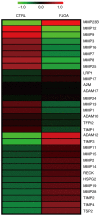Transcriptome sequencing reveals dynamic changes in matrix metalloproteinases in facet joint osteoarthritis
- PMID: 32256724
- PMCID: PMC7086276
- DOI: 10.3892/etm.2020.8488
Transcriptome sequencing reveals dynamic changes in matrix metalloproteinases in facet joint osteoarthritis
Abstract
Osteoarthritis is a general joint disease characterized by articular cartilage degeneration. The extracellular matrix is a principal component in articular cartilage. The dynamic remodeling of the extracellular matrix is involved in the pathological degradation of the articular cartilage. Facet joint osteoarthritis (FJOA) is a common form of osteoarthritis that occurs in the posterior aspect of the vertebral column. However, to the best of our knowledge, the current understanding of the genetic changes in FJOA is limited. The most significantly differentially expressed genes and Gene Ontology categories in FJOA were identified by transcriptome sequencing analysis. The extracellular matrix, matrix metalloproteinases (MMPs) and proteinases of the extracellular matrix were highly involved in FJOA. The canonical signaling pathway 'inhibition of matrix metalloproteinases' was further studied in detail by identifying and validating differentially expressed genes in the signaling pathway. Taken together, the present study revealed changes in MMP-related genes in FJOA and showed the importance of extracellular matrix remodeling in FJOA from a genetic aspect.
Keywords: bioinformatics analysis; extracellular matrix; facet joint osteoarthritis; matrix metalloproteinases; transcriptome sequencing.
Copyright: © Chen et al.
Figures





Similar articles
-
Transcriptional information revealed differentially expressed circular RNAs in facet joint osteoarthritis.Biochem Biophys Res Commun. 2018 Mar 4;497(2):790-796. doi: 10.1016/j.bbrc.2018.02.157. Epub 2018 Feb 19. Biochem Biophys Res Commun. 2018. PMID: 29470979
-
Ingenuity pathway analysis of human facet joint tissues: Insight into facet joint osteoarthritis.Exp Ther Med. 2020 Apr;19(4):2997-3008. doi: 10.3892/etm.2020.8555. Epub 2020 Feb 26. Exp Ther Med. 2020. PMID: 32256786 Free PMC article.
-
Transcriptional analysis of long non-coding RNAs in facet joint osteoarthritis.RSC Adv. 2018 Oct 1;8(59):33695-33701. doi: 10.1039/c8ra04809f. eCollection 2018 Sep 28. RSC Adv. 2018. PMID: 35548800 Free PMC article.
-
The role of collagenolytic matrix metalloproteinases in the loss of articular cartilage in osteoarthritis.Front Biosci. 2006 Sep 1;11:3081-95. doi: 10.2741/2034. Front Biosci. 2006. PMID: 16720377 Review.
-
Profile of Matrix-Remodeling Proteinases in Osteoarthritis: Impact of Fibronectin.Cells. 2019 Dec 22;9(1):40. doi: 10.3390/cells9010040. Cells. 2019. PMID: 31877874 Free PMC article. Review.
Cited by
-
General Caspase Inhibition in Primary Chondrogenic Cultures Impacts Their Transcription Profile Including Osteoarthritis-Related Factors.Cartilage. 2021 Dec;13(2_suppl):1144S-1154S. doi: 10.1177/19476035211044823. Epub 2021 Sep 8. Cartilage. 2021. PMID: 34496641 Free PMC article.
-
BAG3 protects chondrocytes against lumbar facet joint osteoarthritis by regulating autophagy and apoptosis.J Physiol Biochem. 2022 May;78(2):427-437. doi: 10.1007/s13105-021-00865-2. Epub 2022 Mar 7. J Physiol Biochem. 2022. PMID: 35253089
-
Mechanical Load-Induced Upregulation of Talin2 through Non-Canonical Deubiquitination of OTUB1 Drives Facet Joint Osteoarthritis Pathogenesis.Adv Sci (Weinh). 2025 Jul;12(25):e2501046. doi: 10.1002/advs.202501046. Epub 2025 Apr 25. Adv Sci (Weinh). 2025. PMID: 40279639 Free PMC article.
References
-
- García-Carbajal ZY, Garciadiego-Cázares D, Parra-Cid C, Aguilar-Gaytan R, Velasquillo C, Ibarra C, Castro Carmona JS. Cartilage tissue engineering: The role of extracellular matrix (ECM) and novel strategies. 2013 DOI: 10.5772/55917.
LinkOut - more resources
Full Text Sources
